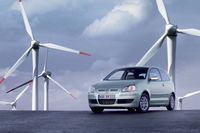BlueMotion Offensive - Volkswagen's Advanced Technologies For Sustained Mobility
AUTO CENTRAL – September 23, 2008: In a special Australian preview, Volkswagen will have two models of the BlueMotion model range on display at this year’s Australian International Motor Show – The Polo BlueMotion and the Passat BlueMotion.
The BlueMotion label is attached to the most economic models in a class with the Polo BlueMotion starting the movement with its introduction in mid 2006. The Passat BlueMotion followed with a world premiere at the Geneva Motor Show in March 2007.
The name BlueMotion not only refers to the automobile itself, its fuel economy and emissions, but comprehensively to the whole brand. Blue – the corporate colour of Volkswagen stands for the elements to be protected, water and air. Motion – embodies the aspect of forward, future-directed mobility. The goal is to protect the earth’s resources for future generations. Within a short time, BlueMotion has advanced to become a quality seal for economy without compromises in driving fun.
Both models on display have recently received international recognition. Both were awarded the “Automobile Environment Certificate”, by ÍKO-TREND, an eco institute. The institute praised Volkswagen for successfully building an ecologically friendly long-distance automobile with a lot of transportation capacity.
Key measures of the BlueMotion model range are engine internal and software changes, longer gear ratios, aerodynamic aids and lowered suspension as well as light alloy wheels with low rolling resistance tyres.
The Passat BlueMotion on display comes with a 2.0 litre 81kw 4-cylinder common rail TDI engine and with 5-speed manual transmission as well as Diesel Particulate Filter (DPF). The maximum torque is 250Nm at 1500-2500rpm. The impressively low fuel consumption of 4.9l/100km (combined cycle) results in CO2 emissions of only 128g/km.
Parameters such as charge pressure, injection timing and exhaust gas recirculation rate were fine-tuned to maximize fuel economy. The TDI’s engine controller also sends a gear recommendation to the standard Multifunctional Display Plus, where the driver can read off which of the total of five forward gears is currently the most efficient.
Another crucial factor in terms of fuel economy is gearing. Compared to initial ratios, the third, fourth and fifth gears of the Passat BlueMotion’s manual five-speed gearbox were lengthened.
At first glance, there do not appear to be any differences in technical body features relative to regular Passat models. That is because nearly all of the modifications are out of sight. In the underbody, for example. Here the brake ducts were covered, and special underbody skirts were integrated forward of the rear axle, left and right. In addition, parts of the air intake louvers are integrated in the radiator trim.
A number of effective changes were also made to the chassis. A careful look at the car reveals that – for the purpose of better aerodynamics – the Passat BlueMotion stands somewhat lower in its wheel housings than the base version; it was lowered 15 millimeters in the front and eight millimeters in the rear.
The Polo BlueMotion at this year’s Australian International Motor Show is equipped with a 1.4 litre 3-cylinder TDI engine with Diesel Particulate Filter (DPF) and 5-speed manual transmission. It has 59kW of power at 4,000rpm and 195Nm of torque at 1800-2200rpm. With a very low fuel-consumption of only 3.8 litres/100km* in a combined cycle the CO2 emissions only come to an impressive 99grams/km.
An important aspect in reducing fuel consumption is optimized aerodynamics. The front end of the Polo BlueMotion in particular was modified significantly. A front spoiler optimized for fluid dynamics as well as a new radiator grille surround that reduces gaps and leads the way through the head wind with low air resistance values. Aerodynamics were also improved at the rear end. Among other things a roof edge spoiler is used here. All aerodynamic measures were based on calculations and test studies in the wind tunnel, after which design engineering converted these findings into suitable components.
Volkswagen Group Australia is evaluating the BlueMotion models with a view to offering this technology in the not to distant future.



